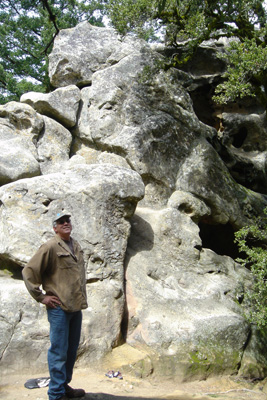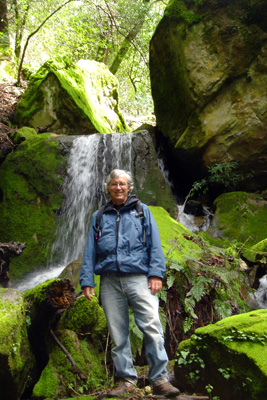
I went for a 60th birthday hike up at Castle Rock Park on Skyline Drive yesterday with Emilio, a software engineer whom I initially got to know as an occasional commenter on this blog, and who I then got to know better as a student in my Computers and Philosophy class at SJSU last fall.

It was a beautiful green day, like descending into the Hollow Earth. We worked our way down to below Castle Rock Falls and back up. And we took a lot of nice pictures. Enough about my birthday already. I’m over it.

I’m almost done reading this great little book on writing, John Gardner, The Art of Fiction: Notes on Craft for Young Writers (Written 1983, Vintage Books edition 1991). Gardner was a novelist in his own right, also famous as a creative writing teacher.

I’ve never read a whole book on writing before; I read part of Annie Lamotte’s Bird by Bird some years ago, but got tired of it: too much Annie and not enough notes on craft. Oh, I’ve looked through Strunk and White as well. (Remember I was a math major, not an English major.)

The reason I bought the Gardner book is that I’ve been thinking about point of view to use for Postsingular, my seventeenth novel. As all the characters are plugged into the orphidnet mind network, their experiences are to some extent internal, and can only be accessed by describing what’s going on in their minds. In the so-called “third-person subjective view,” you get close to a character and describe their thoughts; Gardner says the third-person subjective point of view is really the same as the first-person point of view with “I” replaced by “he” or “she”.

But I want to see into lots of people’s heads. Gardner recommends the “omniscient author” point of view, in which the author freely dips into any of the characters’ minds at any time. Think Tolstoy. Gardner says omniscient author isn’t so much used as in the past, and seems to think it’s underrated. The problem is that omniscient author can be done badly, and instead of appearing elegant, can become, rather, amateurish “wandering point of view”. Phil Dick skirts the border between the two; it doesn’t read that smoothly; maybe if he’d gone into full omniscience it would have worked better; but authorial omniscience requires, perhaps, the writer to make the psychologically difficult (for some) move of thinking of him or herself as a superior being, and this, if done badly comes across real obnox.

What I’m really going to do, probably, is something I’ve done before (as in Realware or As Above, So Below), that is to use a “rotating third-person subjective POV,” that is, to have different chapters or sections written through the eyes of different characters. And not to wander about within a single scene. To some extent, looking through a character’s head promotes them to the status of being a main character, and there’s a sense that a shapely novel shouldn’t have too many main characters.

(Another reason I’m reading Gardner’s book is because I’m mulling over what kind of style might be used for a metanovel. Maybe in a metanovel you really could have all the characters inner lives there to see. More on metanovels in a later entry.)

Even thinking about the authorial omniscient style is freeing me up in any case. I’m starting to feel free to rotate POV without always having to set the shift off with a *** line break.
The Art of Fiction really encourages me overall. I’d been a little anxious that I’d find out I’ve been doing everything wrong for the last sixteen novels. But Gardner tells it just as I feel it. And he really nails some things. And he has some very useful craft suggestions.

“Good description is symbolic not because the writer plants symbols in it but because, by working in the proper way, he forces symbols still largely mysterious to him u into his conscious mind where, little by little as his fiction progresses, he can work with them and finally understand them. To put this another way, the organized and intelligent fictional dream that will eventually fill the reader’s mind begins as a largely mysterious dream in the writer’s mind.” p. 37. And again, “…nothing in what I’m saying is more fundamental than the concept of the uninterrupted fictional dream.” p. 115.

I totally concur with that. First you see a scene as waking dream, then you write it. Actually it’s not that simple. You get a rough dream, you write it, the writing brings up new juxtapositions, symbols, and action problems, you redream it, rewrite it, and iterate. In the end, you have a dream that’s isomorphic to the text. So could you, as metanovelist, publish the thought-states of the dream instead of the text? Yes and no. Part of the pleasure of a text is flavor of the actual words, which have their own peculiar associations. So, okay, for a metanovel, you’d want the dream as a VR, but you’d want the tasty words attached.

“The fictional process is the writer’s way of thinking, a special case of the symbolic process by means of which we do all our thinking …. in some ways the elements of fiction are to a writer what numbers are to a mathematician, the main difference being that we handle fictional elements more intuitively…” p. 51.

That is so great. Painters sometimes say the canvas and oils do some of the work. Same thing with writing. The text helps you think. As I like to say, it’s a thought experiment. But you need that physical apparatus of pen and paper, typewriter or word-processor as surely as a high-energy physicist needs a particle accelerator. You need to smash the words together and see what strange particles appear in the curly trails of the spallation events.

“…the number of fictional elements that exist is finite… By the elements of fiction I mean … “event ideas”such as kidnapping of the loved one …. particles that go to make up character, such as obesity … particles that go to make up setting and atmosphere …” p. 52
Dude! Once we’re talking about recombining a finite number of elements, we’re talking about a computer program! But it needs a good seed. I think of Burroughs’s cut-up method, a crude approx. A metanovel that shuffles its elements each time you access it. Or perhaps continually, like a waterfall.

“Failure to recognize that the central character must act, not simply be acted upon, is the single most common mistake in the fiction of beginners” p. 65. I’ve been guilty of this one; in fact it still requires a conscious effort for me to get my sensitive, put-upon, misunderstood, too-good-for-this-world heroes to get out there and kick some butt.

“The amateur writes, ‘Turning, she noticed two snakes fighting in among the rocks.’ Compare: ‘She turned. In among the rocks two snakes were fighting.’ … vividness urges that almost every occurrence of such phrases as “she noticed” and “she saw” be suppressed in favor of direct presentation of the thing seen.” p. 99. Yes! Of course! I’ll start doing that. In a way this is an elementary example of using omniscient author POV instead of third-person subjective.

On transrealism: “When one writes about an actual parent, or friends, or oneself, all one’s psychological censors are locked on, so that frequently, though not always, one produces either safe but not quite true emotion or else — from the writer’s desire to tell the truth, however it may hurt — bold but distorted, fake emotion. … Real-life characters do sometimes hold their own in fiction, but only those, loved or hated, whom the writer has transformed in his or her own mind, or through the process of writing, to imaginary beings.” p. 126.
I’ve felt that, too, the liberation when a character pulls free of any realworld model I might have had in mind. As then the character can get really unpredictable and funny and deep.

Gardner also talks about rhythm in an interesting way; I’d never quite understood why I had to keep my turning sentences around until they sounded right; it’s a matter of getting a smooth pattern of stressed vs. unstressed beats (as in poetry) to create prose that would be easy and pleasant to read aloud (even though you imagine that readers are silent, the sounds of the prose are subliminally sensed.)

On the way home, I noticed that Lexington Reservoir is overflowing. Last time I remember that happening, Bill Clinton got elected. Like a visible I Ching sign: Overflow. Change is gonna come.

Parting shot: here’s an MPG of the Castle Rock waterfall, a 27 Meg movie of delicious natural computation. Click here to view movie. Seek the gnarl.









March 23rd, 2006 at 10:40 am
That Gardner book is the best I’ve read on writing as well. The collection of techniques are extremely powerful (as well as fun) and help you cut through the stale crust of writing in the same old way for too long.
March 23rd, 2006 at 10:47 am
Best entry ever! 🙂
What about having the Pig be the one the reveals the inner thoughts of the characters? She can even jump between characters in a single paragraph showing how there thoughts are actually connected through her.
March 30th, 2006 at 9:24 pm
[John Gardner on Science Fiction.]
Gardner, John. ON BECOMING A NOVELIST. 1983. New York: W. W. Norton, 1999. 94-95.
For another kind of writer, the most valuable course of study may be one of the hard sciences. This is especially true, obviously, of the serious writer whose chief literary love is sophisticated sci-fi. Though it is true that most science fiction is junk, some of it is excellent. Certain books spring immediately to mind – some of Ray Bradbury’s work or Kurt Vonnegut’s, certain modern classics like BRAVE NEW WORLD and 1984, not to mention works of obvious high-class intent, such as Thomas Pynchon’s GRAVITY’S RAINBOW, William Burroughs’s THE TICKET THAT EXPLODED, or the work of major writers outside of America, like Kobo Abe, Italo Calvino, Raymond Queneau, or Doris Lessing. The number of aesthetically valuable works of science fiction is greater than the academy generally notices. One finds intelligence and emotional power in, for instance, Walter Miller’s A CANTICLE FOR LEIBOWITZ (mentioned earlier), the fiction of Samuel R. Delaney, some of Robert Silverberg, Roger Zelazny, Isaac Asimov, and, when he holds in the fascism, Robert Heinlein. One finds a fair measure of literary merit in Algis J. Budry’s MICHAELMAS or the work of Robert Wilson, whose novels (for instance, SCHRODINGER’S [sic] CAT) out-Barth John Barth without sacrificing the primary quality of good fiction, interesting storytelling. And science fiction is the domain of one of the greatest living writers [sadly now deceased], Stanislaw Lem.
*****
jella
April 16th, 2007 at 9:58 pm
dude, as I read you, you got it backwards: “Turning, she noticed two snakes fighting in among the rocks” is omniscient author POV. “She turned. In among the rocks two snakes were fighting” is third person subjective.
That’s because what’s in the consciousness (or most people) is not the act of observation but the thing observed. “she noticed” is what someone outside her is thinking; she’s all “hey! those snakes are fighting!”
IMHO postsingular you don’t need unity of viewpoint so much as unity of _something_. So pick something else. Unity of object.
That’s why unity of time or unity of topic or unity of mood are so popular. Even unity of weather. You do it all the time, it’s how you make flashbacks or multiple pov work. And don’t forget that you can broaden or narrow your field of view as the action changes from contemplative planning to panicked action.